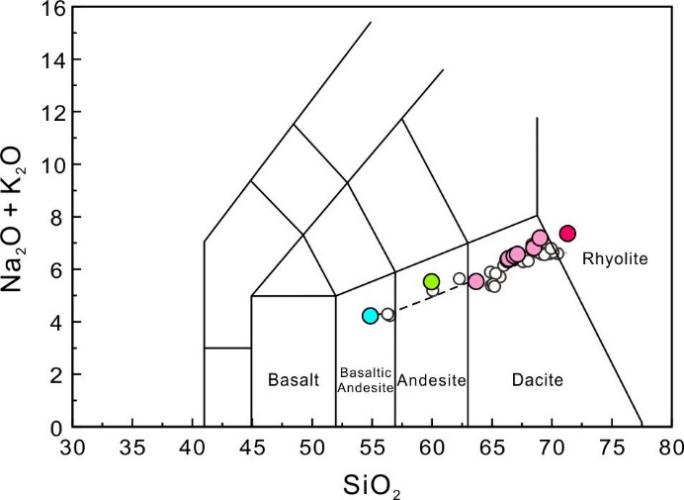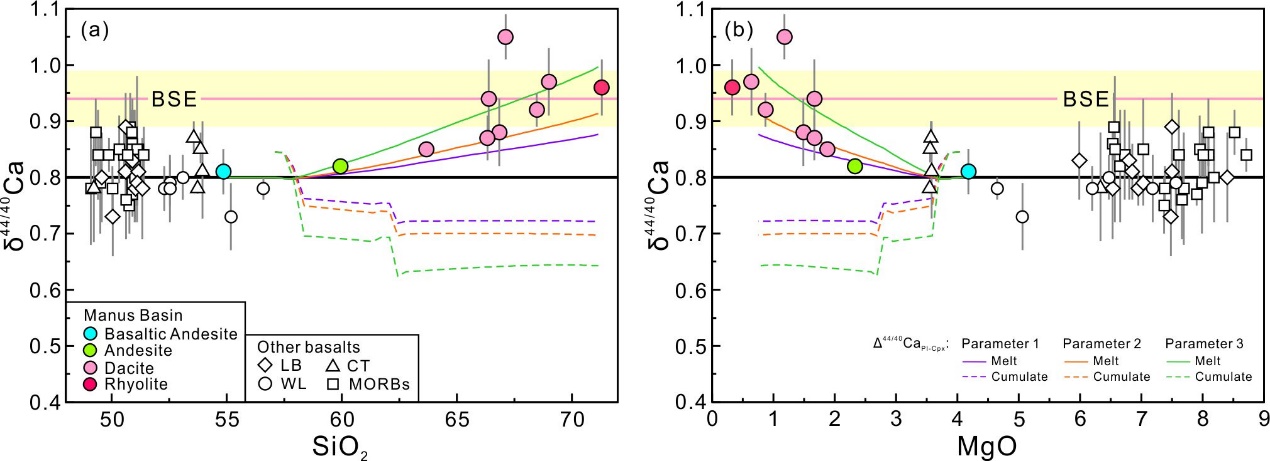Recently, the latest research results of calcium isotopes in Manus Basin volcanic glass by Weidong Sun’s research team from Center of Deep Sea Research, Institute of Oceanography, Chinese Academy of Sciences(IOCAS), have been published in Nature Index journal Geochimica et Cosmochimica Acta, which is of great significance for understanding the fractionation behavior of calcium isotopes in magmatic evolution and applying calcium isotopes to trace high-temperature geological processes.
Calcium isotopes have been used to trace source heterogeneity for volcanic rocks, with the assumption that Ca isotopic fractionation during magma differentiation is limited. Magma differentiation is one of the most common geological processes for volcanic rocks. They usually evolve primarily through fractional crystallization of minerals (e.g., olivine, pyroxene, hornblende, plagioclase) as a result of magma cooling at shallow depths. However, the behavior of Ca isotopes during magma differentiation has not been well documented, except for several studies that focused on geological reference materials and intermediate-mafic rocks.
In the study, Weidong Sun’s research team reported on the high-precision Ca isotopic compositions, major and trace element concentrations, and Sr-Nd isotopic compositions of a series of fresh volcanic glasses from the eastern Manus Basin, which were derived from a common mantle source including basaltic andesite, andesite, dacite and rhyolite. Together with Ca isotopic data in other basalts (e.g., MORBs and BABBs), this team explored the Ca isotopic fractionation in mafic, intermediate and felsic rocks during magma differentiation.
The results show that these volcanic glasses exhibit ~0.25‰ variation in Ca isotopic compositions, with δ44/40Ca ranging from 0.81 ± 0.04 to 1.05 ± 0.04‰. The observed Ca isotopic variations are primarily controlled by its lithology. Specifically, δ44/40Ca of basaltic andesite (0.81 ± 0.04) and andesite (0.82 ± 0.01) are similar to the averages of reported mid-ocean ridge basalts (MORBs; 0.84 ± 0.10; 2SD, N = 26) and back-arc basin basalts (BABBs; 0.80 ± 0.08; 2SD, N = 21) in literature, but do not correlate with SiO2 or MgO contents, indicating that the Ca isotopic fractionation is insignificant during intermediate-mafic magma evolution. As magma differentiation continues, δ44/40Ca of dacite and rhyolite evolves from 0.85 ± 0.01 to 1.05 ± 0.04‰. Moreover, δ44/40Ca of felsic glasses are negatively correlated with Eu/Eu*, which suggests that the increasing δ44/40Ca of felsic glasses is most likely related to plagioclase (Pl) fractional crystallization.
This study demonstrates that Ca isotopes can behave differently at different stages of volcanic magma differentiation. Modeling of fractional crystallization using rhyolite-MELTS shows that the relative Ca fractions in crystallized minerals (e.g., Pl vs. Cpx) and the Ca isotopic fractionation factor between the residual melt and crystallized Pl (αmelt-Pl, which is likely related to the An number of Pl, magma temperature and kinetic effects during crystallization), provide a plausible explanation for the behavior of Ca isotopes during volcanic magma differentiation.
This study is financially supported by grants from the National Natural Science Foundation of China (Nos. 41773009, 41873002 and 41473029), the Strategic Priority Research Program of the Chinese Academy of Sciences (XDB4202030301), the National Key P&D Program of China (2016YFC0600408), Qingdao National Laboratory for Marine Science and Technology (2017SDKJ02) and so on. The first author of this paper is associate researcher Hongli Zhu from Center of Deep Sea Research, IOCAS, and the corresponding authors are associate researcher Congying Li from IOCAS and Prof. Zhaofeng Zhang from Chengdu University of Technology.

Fig. 1 The lithology of volcanic glasses ranges from basaltic andesite to rhyolite.

Fig. 2 Calcium isotopic compositions of volcanic glasses as a function of SiO2 and MgO contents (wt.%).
Hongli Zhu, Renqiang Liao, He Liu, Long Du, He Li, Congying Li*, Zhaofeng Zhang*, Weidong Sun. Calcium isotopic fractionation during magma differentiation: Constraints from volcanic glasses from the eastern Manus Basin. Geochimica et Cosmochimica Acta, 2021(305): 228-242. Calcium isotopic fractionation during magma differentiation: Constraints from volcanic glasses from the eastern Manus Basin - ScienceDirect
(Editor: ZHANG Yiyi)

